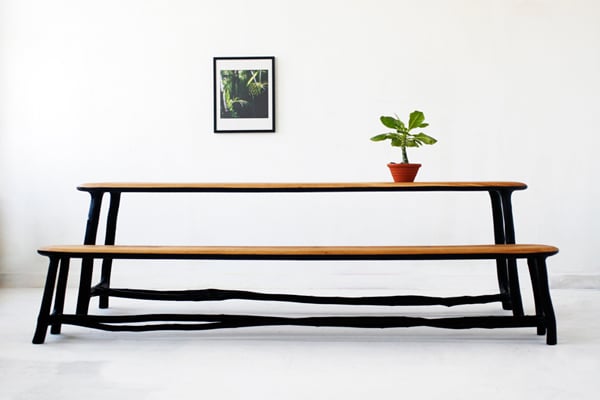The art of rugs: Chillida collection from Nanimarquina
Kompānija Nanimarquina šogad prezentē vienu no
oriģinālākajām paklāju kolekcijām pasaulē. Pārvēršot spāņu mākslinieka Eduardo
Chillida mākslas darbus izsmalcinātos paklājos, Nanimarquina pārsteidz ar savu spēju apvienot dizainu, mākslu un
funkcionalitāti, piedāvājot saviem klientiem neatkārtojamus interjera
elementus. Eduardo Chillida daiļrade ietver sevī lielākos 20. gadsimta mākslas
sasniegumus, tādēļ Nanimarquina ir
izveidojuši Chillida kolekciju, kuras
pamatā ir hronoloģiska viņa darbu izlase, sākot no 1948. gada Figura Humana līdz 1966. gada Collage, kas ilustrē darba procesu pirms
viņa slavenākās skulptūras Peine del
Viento tapšanas. Paklāju kolekcijā arī ir iekļauti divi attēli ar viņa
slavenajām rokām no 1990. gadiem, kā arī 1993. un 1994. gada Gravitación, kur viņš rada jaunu reljefa formu – skulptūru, kas veidota no papīra.
Visi šie darbi ir pārveidoti
rūpīgos, ar rokām taisītos paklājos, izmantojot dažādas tehnikas un dažādus
materiālus (vilnu, zīdu un mohēru), lai perfekti attēlotu Eduardo Chillida
mākslas darbu esenci.
Eduardo Chillida ir
dzimis 1924. gada 10. janvārī San Sebastián pilsētā, un 1943. gadā devās uz
Madridi, lai studētu arhitektūru. 1947. gadā viņš nolēma turpināt izglītoties
citā virzienā un sāka mācīties zīmēt Círculo de Bellas Artes.
Nonākot Parīzē,
Eduardo Chillida sāka veidot skulptūras, izstādot vienu no saviem darbiem Salón
de Mayo. Kad mākslinieks pārcēlās uz Hernani pilsētu, viņš atklāja dzelzs
vilinājumu un izveidoja savu pirmo darbu no šī materiāla – Ilarik.
Jau pēc trim gadiem
notika pirmā Chillida personālizstāde Madridē un tajā pašā gadā Aranzazu
bazilika pasūtīja māksliniekam durvis. 1958. gadā Chillida 29. Venēcijas
biennālē saņēma starptautisko galveno balvu tēlniecībā, kas tikai uzsāka viņa
apbalvojumiem bagāto karjeru. Mākslinieka darbi ir sastopami vairāk kā 20
muzejos visā pasaulē, un viņa izstādes ir notikušas gan Berlīnē, gan Londonā,
gan Ņujorkā.
Eduardo Chillida
mākslas darbi publiskajai telpai sastāda lielu daļu viņa daiļrades un ir
aplūkojami gan Madridē, gan Lundā, gan Teherānā, gan Barselonā un Gernikā.
2000. gadā tika
atklāts Chillida-Leku muzjes, kas
šobrīd izstāda lielu daudzumu mākslinieka darbu, kuri pastāvīgi tiek iekļauti
dabiskajā vidē.
2002. gada 19.
augustā Eduardo Chillida aizgāja mūžībā, tā arī nesagaidot sava lielā sapņa – Tindaya
projekta (publisks piemineklis pašā kalnu viducī) – īstenošanos.
This year the
company Nanimarquina presents one of
the most original rug collections in the world. By transforming the Spanish
artist Eduardo Chillida’s artworks into sophisticated rugs, Nanimarquina surprises with its ability
to unite design, art and functionality, thus offering their clients unique
interior elements. The oeuvre of Eduardo Chillida includes some of the greatest
accomplishments in 20th century arts, which is why Nanimarquina have created the Chillida
collection, which is based on a chronological selection of this works,
beginning with the 1948 Figura Humana up
to the 1966 Collage, which
illustrates the work process before the creation of his most famous scupture Peine del Viento. The rug collection
also includes two images of his famous hands from the 1990s, as well as Gravitación 1993 and 1994, where he creates a new form of relief by making a sculpture
from paper.
All these works are carefully
transformed into handmade rugs, using different techniques and materials (wool,
silk and mohair) to mirror the essence of Eduardo Chillida’s artworks.
Eduardo Chillida was born on
January the 10th, 1924 in San Sebastián, and in 1943 went to Madrid to study
architecture. In 1947 he decided to continue his education in a different
direction and began learning to draw in Círculo de Bellas Artes.
Arriving in Paris,
Eduardo Chillida began to make sculptures, exhibiting one of his first works in
Salón de Mayo. When the artist moved to Hernani, he discovered the appeal of
iron and created his first work from the material – Ilarik.
After already three
years the first Chillida solo show took place in Madrid and the same year the Basilica
of Aranzazu commissioned a door from the artist. In 1958 Chillida received the
International Grand Prize for Sculpture in the 29th Venice Biennal, which only
began his award-winning career. The artist’s works can be seen in more than 20
museums all over the world, and he’s been exhibited in such cities as Berlin,
London and New York.
Public works were a
big part of Eduardo Chillida’s oeuvre and are visible in Madrid, Lund, Tehran, Barcelona
and Guernica.
The Chillida-Leku museum was opened in 2000
and at the moment it exhibits a big part of the artist’s work, which constantly
engages with the natural environment.
Eduardo Chillida
passed away on the 19th of August, 2002, without living to see the completion
of his big dream – Tindaya project, a
public monument in the heart of mountains.




























